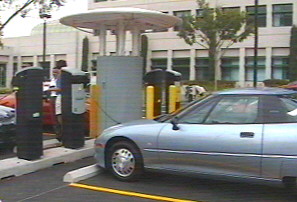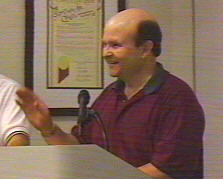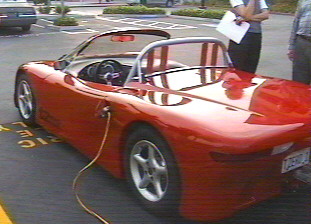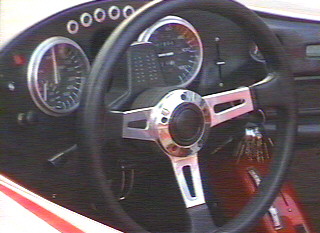

![]()

For the second EV1 club meeting, charging was centered around the SCAQMD's new commercial charger. Saturn personnel again handled rotating cars through the chargers (now that's service!).

Bob Purcell, head of GM's EV1 program gave a very informative talk about the EV1 project history and future direction. Of particular interest:

[Right] John Howell (Saturn Director of Marketing and Product Planning) also fielded some questions and comments regarding the GM/Saturn marketing campaign which, to many in the club, did not appear to be very effective.

[Left] Edward Kjaer of Edison EV (Director of Marketing and Sales) updated everyone on the (slow) progress on building up the charging infrastructure. It sounded like there was no shortage of red tape to trip them up (e.g. handicap access to chargers)!
Edison EV is working on various ways to let EV1 owners know where chargers are coming online:


A surprise to me was that Alan Cocconi, who designed the original
Impact electronics, was also present. Besides bringing a friend's
leased EV1, he brought along his prototype TZero car (at the
right end of the photo above) which his company, AC Propulsion,
Inc., will be building and selling in small quantities for a bit
more than an EV1 ($85,000!).

Although it is not very clear in this photo, a close look at the cockpit of the TZero shows some things we want in the EV1. For example, Cocconi has individual LEDs (located on the top of the steering column) for each battery module to indicate charge state. This gives better warning of a bad module than the EV1. When we had a battery fail in our EV1, the miles-remaining indicator went abruptly from 15 to zero before we had gone more than a mile more!
Another feature we want is better feedback on the power use. The TZero has a gauge reading in amps, with a fine scale for 0-50 amps, and a coarser one for above 50 amps. This is much better than the EV1's uncalibrated 10-bar nonlinear scale. A better power meter would allow the driver to fine tune his power conserving technique.
And finally, Cocconi's approach of building the charger into the car makes sense since it allows the car to plug into a conventional 220V outlet. His argument that it reduces the cost of the public charging infrastructure (making it more likely to succeed) and increases the convenience to the driver is very compelling!
For the moment, Cocconi's solution for his friend's EV1 was to
purchase a floor-mounted EV1 charger (required for the longer
charger paddle cord), modify it, and secure it to the ledge
behind the passenger seats! This allows him to charge wherever
a standard 220V outlet is available. He even had a one-page
handout describing how he did it.
GM, are you listening?